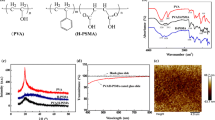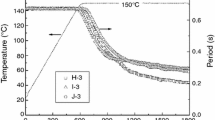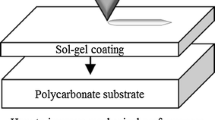Abstract
Newly synthesized polycarbonate diols containing hindered urea (PCD-HUs) were employed to modify the scratch-healing properties of conventional two-component clearcoats. To elucidate their contributions to the crosslinking properties of the coatings under conventional thermal curing (150°C), the real-time rheological properties of the clearcoat mixtures were measured using a rotational rheometer in the small-amplitude oscillatory shear mode. A dynamic mechanical analysis was carried out to compare the thermomechanical properties of the cured clearcoat free films. PCD-HU, a key component for the tuning of the scratch-healing, was further identified by analyzing the clearcoat layer cured over a phosphated metal substrate with undercoats such as primer and basecoat as a precoated metal (PCM) sheet. Elastic recovery and scratch profiles of the outermost clearcoat layer in the PCM sheet were acquired through nano-indentation and nano-scratch tests by gradually increasing the quantitative normal force. Finally, the healing patterns of the scratches on various clearcoat layers at a certain normal force were visualized by three-dimensional and one-dimensional cross-cut images using atomic force microscopy under specified temperature and healing time conditions. The surface durability provided by the PCD-HU in the clearcoat layer was confirmed by repeated scratching and healing tests on the same surface positions. Therefore, the coating layer containing HU, which possessed similar surface mechanical properties to those of conventional references, exhibited better scratch-healing performance.











Similar content being viewed by others
References
Gregorovich, B, Hazan, I, “Environmental Etch Performance, and Scratch and Mar of Automotive Clearcoats.” Prog. Org. Coat., 24 131–146 (1994)
Lange, J, Luisier, A, Hult, A, “Influence of Crosslink Density, Glass Transition Temperature and Addition of Pigment and Wax on the Scratch Resistance of an Epoxy Coating.” J. Coat. Technol., 69 77–82 (1997)
Kotnarowska, D, Wojtyniak, M, “Nanotechnology Application to Automotive Coating Manufacturing.” J. KONES, 14 253–258 (2007)
Tahmassebi, N, Moradian, S, Ramezanzadeh, B, Khosravi, A, Behdad, S, “Effect of Addition of Hydrophobic Nano Silica on Viscoelastic Properties and Scratch Resistance of an Acrylic/Melamine Automotive Clearcoat.” Tribol. Int., 43 685–693 (2010)
Scrinzi, E, Rossi, S, Kamarchik, P, Deflorian, F, “Evaluation of Durability of Nano-Silica Containing Clear Coats for Automotive Applications.” Prog. Org. Coat., 71 384–390 (2011)
Lee, DG, An, SY, Um, MS, Choi, WJ, Noh, SM, Jung, HW, Oh, JK, “Photo-Induced Thiol-Ene Crosslinked Polymethacrylate Networks Reinforced with Al2O3 Nanoparticles.” Polymer, 101 119–126 (2016)
Ramezanzadeh, B, Moradian, S, Tahmasebi, N, Khosravi, A, “Studying the Role of Polysiloxane Additives and Nano-SiO2 on the Mechanical Properties of a Typical Acrylic/Melamine Clearcoat.” Prog. Org. Coat., 72 621–631 (2011)
Streitberger, H, Dossel, K, Automotive Paints and Coatings. WILEY-VCH, Weinheim (2008)
Urban, M, Allison, C, Finch, C, Tatro, B, “Interfacial Studies of Crosslinked Urethanes: Part III. Structure–Property Relationships in Polyester Waterborne Polyurethanes.” J. Coat. Technol., 71 75–85 (1999)
Bertrand-Lambotte, P, Loubet, J, Verpy, C, Pavan, S, “Nano-Indentation, Scratching and Atomic Force Microscopy for Evaluating the Mar Resistance of Automotive Clearcoats: Study of the Ductile Scratches.” Thin Solid Films, 398 306–312 (2001)
Blaiszik, BJ, Kramer, SL, Olugebefola, SC, Moore, JS, Sottos, NR, White, SR, “Self-Healing Polymers and Composites.” Ann. Rev. Mater. Res., 40 179–211 (2010)
Yoon, JA, Kamada, J, Koynov, K, Mohin, J, Nicolaÿ, R, Zhang, Y, Balazs, AC, Kowalewski, T, Matyjaszewski, K, “Self-Healing Polymer Films Based on Thiol–Disulfide Exchange Reactions and Self-Healing Kinetics Measured Using Atomic Force Microscopy.” Macromolecules, 45 142–149 (2011)
AbdolahZadeh, M, Esteves, A, Van der Zwaag, S, Garcia Espallargas, S, “On the Healing Mechanism of Sol–Gel Derived Hybrid Materials Containing Dynamic Di-Sulfide Bonds,” ICSHM 2013: Proceedings of the 4th International Conference on Self-Healing Materials, Ghent, Belgium (2013)
Yarmohammadi, M, Shahidzadeh, M, Ramezanzadeh, B, “Designing an Elastomeric Polyurethane Coating with Enhanced Mechanical and Self-Healing Properties: The Influence of Disulfide Chain Extender.” Prog. Org. Coat., 121 45–52 (2018)
Gao, F, Cao, J, Wang, Q, Liu, R, Zhang, S, Liu, J, Liu, X, “Properties of UV-Cured Self-Healing Coatings Prepared with PCDL-Based Polyurethane Containing Multiple H-Bonds.” Prog. Org. Coat., 113 160–167 (2017)
Grzelak, AW, Boinard, P, Liggat, JJ, “The Influence of Diol Chain Extender on Morphology and Properties of Thermally-Triggered UV-Stable Self-Healing Polyurethane Coatings.” Prog. Org. Coat., 122 1–9 (2018)
Liu, YL, Chuo, TW, “Self-Healing Polymers Based on Thermally Reversible Diels–Alder Chemistry.” Polym. Chem., 4 2194–2205 (2013)
Kim, SY, Lee, TH, Park, YI, Nam, JH, Noh, SM, Cheong, IW, Kim, JC, “Influence of Material Properties on Scratch-Healing Performance of Polyacrylate-Graft-Polyurethane Network that Undergo Thermally Reversible Crosslinking.” Polymer, 128 135–146 (2017)
Sung, S, Kim, SY, Lee, TH, Favaro, G, Park, YI, Lee, SH, Ahn, JB, Noh, SM, Kim, JC, “Thermally Reversible Polymer Networks for Scratch Resistance and Scratch Healing in Automotive Clear Coats.” Prog. Org. Coat., 127 37–44 (2019)
Zechel, S, Geitner, R, Abend, M, Siegmann, M, Enke, M, Kuhl, N, Klein, M, Vitz, J, Gräfe, S, Dietzek, B, “Intrinsic Self-Healing Polymers with a High E-Modulus Based on Dynamic Reversible Urea Bonds.” NPG Asia Mater., 9 e420 (2017)
Ying, H, Zhang, Y, Cheng, J, “Dynamic Urea Bond for the Design of Reversible and Self-Healing Polymers.” Nat. Commun., 5 3218 (2014)
Lin, L, Blackman, G, Matheson, R, “A New Approach to Characterize Scratch and Mar Resistance of Automotive Coatings.” Prog. Org. Coat., 40 85–91 (2000)
Bertrand-Lambotte, P, Loubet, J, Verpy, C, Pavan, S, “Understanding of Automotive Clearcoats Scratch Resistance.” Thin Solid Films, 420 281–286 (2002)
Shen, W, Mi, L, Jiang, B, “Characterization of Mar/Scratch Resistance of Coatings with a Nano-Indenter and a Scanning Probe Microscope.” Tribol. Int., 39 146–158 (2006)
Noh, SM, Lee, JW, Nam, JH, Park, JM, Jung, HW, “Analysis of Scratch Characteristics of Automotive Clearcoats Containing Silane Modified Blocked Isocyanates via Carwash and Nano-Scratch Tests.” Prog. Org. Coat., 74 192–203 (2012)
Noh, SM, Nam, JH, Oh, JK, Jung, HW, “Scratch and Recovery Characteristics of Automotive Clearcoats Containing Blocked Polyisocyanate Crosslinkers.” J. Coat. Technol. Res., 12 85–95 (2015)
Kutschera, M, Sander, R, Herrmann, P, Weckenmann, U, Poppe, A, “Scratch Resistance of Automobile Clearcoats: Chemistry and Characterization on the Micro-and Nanoscale.” J. Coat. Technol. Res., 3 91–97 (2006)
Shen, WC, Jiang, B, Jones, FN, “Measurement of Mar Resistance and Study of Marring Mechanism of Polymeric Coatings with Scanning Probe Microscope.” J. Coat. Technol., 72 89–95 (2000)
Seubert, C, Nichols, M, Henderson, K, Mechtel, M, Klimmasch, T, Pohl, T, “The Effect of Weathering and Thermal Treatment on the Scratch Recovery Characteristics of Clearcoats.” J. Coat. Technol. Res., 7 159–166 (2010)
Park, JI, Choe, A, Kim, MP, Ko, H, Lee, TH, Noh, SM, Kim, JC, Cheong, IW, “Water-Adaptive and Repeatable Self-Healing Polymers Bearing Bulky Urea Bonds.” Polym. Chem., 9 11–19 (2018)
Feng, ZQ, He, QC, Zeng, Q, Joli, P, “Theory of Nanoindentation, Chapter 26.” In: Sattler, KD (ed.) Handbook of Nanophysics: Functional Nanomaterials. CRC Press, Boca Raton (2010)
Jung, KI, Hwang, SO, Kim, NH, Lee, DG, Lee, JH, Jung, HW, “Effect of Methacryloxypropyl and Phenyl Functional Groups on Crosslinking and Rheological and Mechanical Properties of Ladder-Like Polysilsesquioxane Hard Coatings.” Prog. Org. Coat., 124 129–136 (2018)
ASTM D7187-15, Standard Test Method for Measuring Mechanistic Aspects of Scratch/Mar Behavior of Paint Coatings by Nanoscratching (2015)
Feng, L, Benhamida, BN, Lu, CY, Sung, LP, Morel, P, Detwiler, AT, Skelly, JM, Baker, LT, Bhattacharya, D, “Fundamentals and Characterizations of Scratch Resistance on Automotive Clearcoats.” Prog. Org. Coat., 125 339–347 (2018)
Scheltjens, G, Diaz, M, Brancart, J, Van Assche, G, Van Mele, B, “A Self-Healing Polymer Network Based on Reversible Covalent Bonding.” React. Funct. Polym., 73 413–420 (2013)
Ionescu, M, Chemistry and Technology of Polyols for Polyurethanes. Smithers Rapra Publishing, Shrewsbury (2005)
Stowell, JC, Padegimas, SJ, “Urea Dissociation. Measure of Steric Hindrance in Secondary Amines.” J. Organ. Chem., 39 2448–2449 (1974)
Hutchby, M, Houlden, CE, Ford, JG, Tyler, SN, Gagné, MR, Lloyd-Jones, GC, Booker-Milburn, KI, “Hindered Ureas as Masked Isocyanates: Facile Carbamoylation of Nucleophiles Under Neutral Conditions.” Angew. Chem. Int. Edit., 48 8721–8724 (2009)
Vega, J, Grande, A, Van der Zwaag, S, Garcia, S, “On the Role of Free Carboxylic Groups and Cluster Conformation on the Surface Scratch Healing Behaviour of Ionomers.” Eur. Polym. J., 57 121–126 (2014)
Acknowledgments
This study was supported by the Ministry of Trade, Industry & Energy (MOTIE, Korea), under the Industrial Technology Innovation Program (No. 10067082).
Author information
Authors and Affiliations
Corresponding authors
Additional information
Publisher's Note
Springer Nature remains neutral with regard to jurisdictional claims in published maps and institutional affiliations.
Rights and permissions
About this article
Cite this article
Lee, D.G., Sung, S., Oh, D.G. et al. Application of polycarbonate diol containing hindered urea to polyurethane-based clearcoats for tuning of scratch-healing properties. J Coat Technol Res 17, 963–976 (2020). https://doi.org/10.1007/s11998-019-00316-0
Published:
Issue Date:
DOI: https://doi.org/10.1007/s11998-019-00316-0




